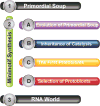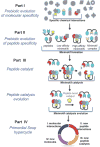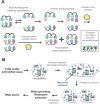The minimotif synthesis hypothesis for the origin of life
- PMID: 28083146
- PMCID: PMC5223774
- DOI: 10.15761/JTS.1000154
The minimotif synthesis hypothesis for the origin of life
Abstract
Several theories for the origin of life have gained widespread acceptance, led by primordial soup, chemical evolution, metabolism first, and the RNA world. However, while new and existing theories often address a key step, there is less focus on a comprehensive abiogenic continuum leading to the last universal common ancestor. Herein, I present the "minimotif synthesis" hypothesis unifying select origin of life theories with new and revised steps. The hypothesis is based on first principles, on the concept of selection over long time scales, and on a stepwise progression toward complexity. The major steps are the thermodynamically-driven origination of extant molecular specificity emerging from primordial soup leading to the rise of peptide catalysts, and a cyclic feed-forward catalytic diversification of compound and peptides in the primordial soup. This is followed by degenerate, semi-partially conservative peptide replication to pass on catalytic knowledge to progeny protocells. At some point during this progression, the emergence of RNA and selection could drive the separation of catalytic and genetic functions, allowing peptides and proteins to permeate the catalytic space, and RNA to encode higher fidelity information transfer. Translation may have emerged from RNA template driven organization and successive ligation of activated amino acids as a predecessor to translation.
Keywords: abiogenesis; chemical evolution; first principles; minimotif; natural selection; peptide.
Figures



Similar articles
-
On the origin of the translation system and the genetic code in the RNA world by means of natural selection, exaptation, and subfunctionalization.Biol Direct. 2007 May 31;2:14. doi: 10.1186/1745-6150-2-14. Biol Direct. 2007. PMID: 17540026 Free PMC article.
-
Evolution of the first genetic cells and the universal genetic code: a hypothesis based on macromolecular coevolution of RNA and proteins.J Theor Biol. 2014 Sep 21;357:220-44. doi: 10.1016/j.jtbi.2014.06.003. Epub 2014 Jun 12. J Theor Biol. 2014. PMID: 24931677
-
A stepwise emergence of evolution in the RNA world.FEBS Lett. 2025 May 12. doi: 10.1002/1873-3468.70065. Online ahead of print. FEBS Lett. 2025. PMID: 40353364
-
The Role of Reverse Transcriptase in the Origin of Life.Biochemistry (Mosc). 2019 Aug;84(8):870-883. doi: 10.1134/S0006297919080030. Biochemistry (Mosc). 2019. PMID: 31522669 Review.
-
Physico-chemical and evolutionary constraints for the formation and selection of first biopolymers: towards the consensus paradigm of the abiogenic origin of life.Chem Biodivers. 2007 Sep;4(9):2003-15. doi: 10.1002/cbdv.200790167. Chem Biodivers. 2007. PMID: 17886857 Review.
Cited by
-
Has Inositol Played Any Role in the Origin of Life?Life (Basel). 2017 Jun 5;7(2):24. doi: 10.3390/life7020024. Life (Basel). 2017. PMID: 28587245 Free PMC article.
-
The origin of genetic and metabolic systems: Evolutionary structuralinsights.Heliyon. 2023 Mar 11;9(3):e14466. doi: 10.1016/j.heliyon.2023.e14466. eCollection 2023 Mar. Heliyon. 2023. PMID: 36967965 Free PMC article.
-
Nrf1 acts as a highly-conserved determinon for maintaining robust redox homeostasis in the eco-evo-devo process of life histories.Cell Stress. 2025 Jul 7;9:65-142. doi: 10.15698/cst2025.07.306. eCollection 2025. Cell Stress. 2025. PMID: 40703332 Free PMC article. Review.
-
Minimotif Miner 4: a million peptide minimotifs and counting.Nucleic Acids Res. 2018 Jan 4;46(D1):D465-D470. doi: 10.1093/nar/gkx1085. Nucleic Acids Res. 2018. PMID: 29140456 Free PMC article.
-
On the evolution of protein-adenine binding.Proc Natl Acad Sci U S A. 2020 Mar 3;117(9):4701-4709. doi: 10.1073/pnas.1911349117. Epub 2020 Feb 20. Proc Natl Acad Sci U S A. 2020. PMID: 32079721 Free PMC article.
References
-
- Oparin AI. Evolution of the concepts of the origin of life, 1924–1974. Orig Life. 1976;7:3–8. - PubMed
-
- Joyce GF. The antiquity of RNA-based evolution. Nature. 2002;418:214–221. - PubMed
-
- Kun Á, Szilágyi A, Könnyű B, Boza G, Zachar I, et al. The dynamics of the RNA world: insights and challenges. Ann N Y Acad Sci. 2015;1341:75–95. - PubMed
-
- Yarus M. Life from an RNA world: the ancestor within. Harvard Univ. Press; Cambridge, Mass: 2010.
-
- Bernal JD. The physical basis of life. Proceedings of the Physical Society. Section A. 1949;62:746–746.
Grants and funding
LinkOut - more resources
Full Text Sources
Other Literature Sources
